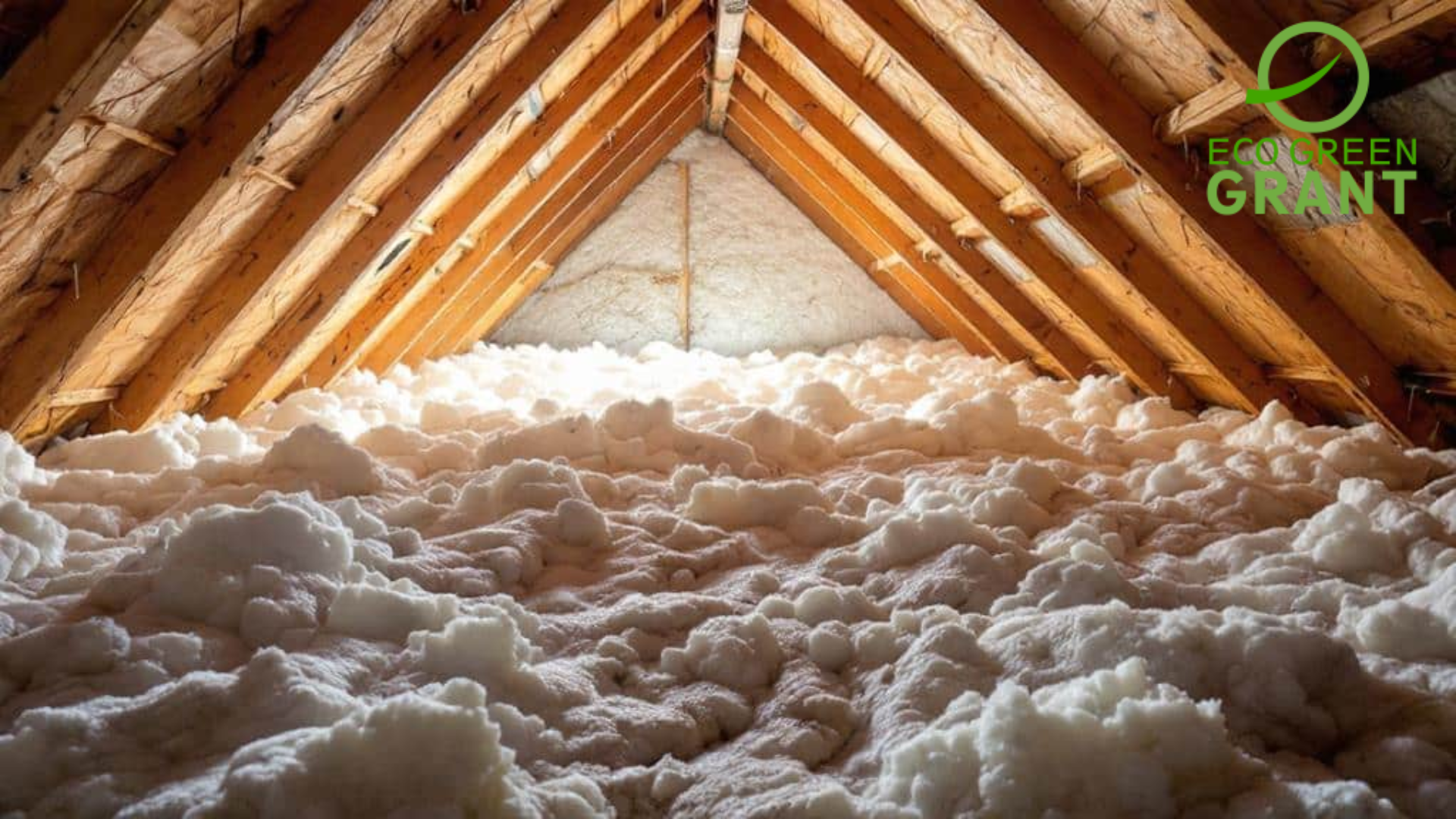Loft insulation is a key player in improving energy efficiency and reducing heating costs. However, a question often arises: “Is too much loft insulation bad?” In this article, we will explore the potential risks of over-insulating your home, provide guidance on optimal insulation levels, and answer common concerns. EcoGreenGrant is here to ensure you achieve the perfect balance in loft insulation to maximize comfort and efficiency.
Is Too Much Loft Insulation Bad?
What is Loft Insulation?
Loft insulation is a material placed in the roof space to reduce heat loss. It acts as a barrier to keep warm air inside during winter and prevent heat from entering during the summer. Effective loft insulation can help lower your energy bills by reducing the amount of energy needed for heating and cooling.
How Does Loft Insulation Work?
The primary function of loft insulation is to trap air within its layers, preventing heat from escaping through the roof. By doing so, it keeps the internal environment of your home stable, reducing the need for constant heating or air conditioning. Proper insulation can significantly reduce your energy consumption, leading to lower utility bills.
Benefits of Loft Insulation
Loft insulation brings multiple benefits to your home, such as energy savings, enhanced comfort, and environmental impact reduction. It helps regulate temperature indoors, making your home warmer in winter and cooler in summer. Additionally, it supports sustainability by reducing carbon emissions, contributing to a greener environment.
Why Is Loft Insulation Essential for Energy Efficiency?
Insulation in the loft is one of the most effective ways to improve energy efficiency in your home. By preventing heat from escaping, it reduces the workload of your heating system, leading to lower energy consumption. This is especially crucial in the winter months when energy use tends to be higher.
The Risks of Over-Insulating Your Loft
Can Too Much Loft Insulation Cause Problems?
While insulation is essential, too much can actually have negative effects. Over-insulating your loft can restrict proper ventilation, leading to issues such as increased moisture buildup and condensation. This can damage the structure of your home and create unhealthy living conditions by encouraging mold growth.
Does Excess Insulation Lead to Mold Growth?
Excessive loft insulation can result in inadequate airflow, which increases humidity and traps moisture. This environment fosters mold and mildew growth, which can damage both the insulation and your home’s structure. It’s important to install a sufficient amount of insulation while maintaining proper ventilation to avoid such problems.
What Are the Health Risks of Over-Insulation?
Over-insulating your loft can cause poor indoor air quality due to trapped moisture and lack of ventilation. This can lead to health issues such as respiratory problems or allergies. It’s essential to balance insulation with proper airflow to ensure your home remains healthy and comfortable for all residents.
Can Too Much Insulation Affect Your Heating System?
Over-insulation can make your home too sealed, preventing heat from circulating properly. In such cases, your heating system may overwork itself, leading to higher energy bills and potentially reducing its lifespan. Proper insulation ensures your system operates efficiently without the added strain of excessive insulation.
Signs You Might Have Too Much Loft Insulation
What Are the Warning Signs of Over-Insulation?
If you notice condensation, musty smells, or visible mold in your loft, these could be signs of over-insulation. Excess insulation blocks proper ventilation, leading to a buildup of moisture. Regularly checking your loft can help you identify these signs before they become significant issues.
How Can You Check Insulation Levels in Your Loft?
The first step in checking whether you have too much loft insulation is to measure the depth of the insulation. The UK government recommends a depth of 270mm for optimal energy efficiency. If your insulation exceeds this, you may want to consult with a professional to assess whether it’s too much for your home’s needs.
Why Should You Monitor Your Loft Insulation Regularly?
It’s important to inspect your loft insulation regularly to ensure it remains effective. Over time, insulation can compress or degrade, reducing its effectiveness. Monitoring ensures that the insulation maintains its energy efficiency and prevents potential risks associated with excessive material.
What To Do If You Have Too Much Loft Insulation?
If you suspect that your loft insulation is too thick, it’s time to consult with a professional insulation installer. EcoGreenGrant can provide expert advice on whether your insulation levels are appropriate and make recommendations for adjustments if necessary.
How to Achieve the Right Amount of Loft Insulation
How Much Insulation Is Enough for a Standard Home?
The ideal insulation depth for a typical home is around 270mm. This ensures that your loft is insulated enough to retain heat without causing over-sealing or poor ventilation. EcoGreenGrant professionals can assess your home’s specific needs and recommend the right insulation level.
How to Maintain Proper Loft Insulation?
Proper installation is key to ensuring your loft insulation remains effective. It’s also important to ensure there is adequate ventilation in the loft. Regular checks and professional assessments from EcoGreenGrant can help keep your insulation functioning at its best.
Should You Insulate Over Existing Insulation?
In some cases, it may be necessary to add additional insulation on top of existing material. However, it’s important to ensure that this does not block vents or reduce airflow in the loft. EcoGreenGrant’s experts can help determine whether this is a suitable option for your home.
What Are the Costs of Loft Insulation Installation?
The cost of installing loft insulation can vary based on the size of your home and the materials used. However, the benefits of insulation, such as lower energy bills, make it a worthwhile investment. Contact EcoGreenGrant for a personalized quote and advice on the best insulation options for your home.
The Benefits of Professional Loft Insulation Installation
Why Should You Hire a Professional for Loft Insulation?
Professional installation ensures that the right amount of insulation is applied and that it’s done correctly to prevent long-term problems. EcoGreenGrant offers expert installation services to ensure your loft insulation is installed to the highest standards, maximizing energy efficiency and comfort.
How Does Professional Installation Prevent Over-Insulation?
Professional installers, like EcoGreenGrant, can assess your home and determine the exact amount of insulation needed. They will ensure that it’s installed correctly and doesn’t block vital ventilation points, preventing the risks associated with over-insulation.
What Are the Long-Term Benefits of Professional Installation?
Professional insulation installation can provide long-term energy savings by optimizing your home’s insulation. It also helps prevent costly problems like mold and condensation. EcoGreenGrant ensures that your loft insulation performs efficiently for years to come.
Can Professional Installation Increase the Lifespan of Your Insulation?
Yes, a properly installed insulation system lasts longer and works more efficiently. Professional installation from EcoGreenGrant helps ensure that your insulation is correctly placed, maintaining its effectiveness for an extended period without the risks of degradation or over-insulation.
Maintaining Your Loft Insulation Over Time
How Can You Ensure Long-Term Loft Insulation Efficiency?
To ensure your insulation continues to perform efficiently, it’s important to monitor its condition and make repairs as needed. Checking for gaps, settling, or compression can help maintain the insulation’s effectiveness. Regular maintenance by EcoGreenGrant can help ensure your insulation works optimally for years.
What Is the Role of Ventilation in Loft Insulation Maintenance?
Ventilation plays a critical role in maintaining your loft insulation. Without proper airflow, the insulation can trap moisture, leading to mold and condensation issues. It’s essential to install sufficient ventilation alongside insulation to ensure long-term performance.
How Often Should You Inspect Loft Insulation?
Regular inspections are essential for ensuring the continued effectiveness of your loft insulation. You should inspect your insulation at least once a year, especially after severe weather or temperature fluctuations. EcoGreenGrant offers professional inspection services to help you keep your insulation in top condition.
What Should You Do if Your Loft Insulation Needs Replacement?
If your loft insulation is damaged or ineffective, it’s best to replace it as soon as possible. EcoGreenGrant provides expert insulation replacement services, ensuring your home remains energy-efficient and comfortable.
FAQs
What happens if loft insulation is too thick?
If loft insulation is too thick, it can block necessary ventilation pathways. This leads to excess moisture build-up, creating ideal conditions for mold and condensation. Over time, this can damage the roofing structure and reduce indoor air quality. It can also reduce the effectiveness of the insulation itself. A balance in thickness is essential for both performance and safety.
Can too much insulation cause health problems?
Yes, excessive loft insulation can affect air circulation, leading to trapped humidity and poor indoor air quality. This can aggravate asthma, allergies, or respiratory conditions. Mold growth from moisture buildup can also pose health risks. Proper airflow is essential for a healthy indoor environment. EcoGreenGrant ensures insulation meets both comfort and health standards.
How do I know if I have over-insulated my loft?
Look for signs like condensation on ceilings, a musty smell, or mold near the attic area. Another indicator is if your rooms feel stuffy or too warm even when the heating is off. These symptoms often point to trapped air and inadequate ventilation. Measuring insulation depth can confirm this—anything far beyond 270mm could be a concern. Consulting EcoGreenGrant can help you assess and adjust.
Will removing excess insulation improve air quality?
Yes, removing excess insulation allows your loft to breathe and prevents trapped humidity. This can significantly reduce mold growth and improve the overall air quality in your home. It also ensures your heating and ventilation systems work more efficiently. Properly balanced insulation enhances comfort and reduces health risks. Always consult a professional before removing insulation.


